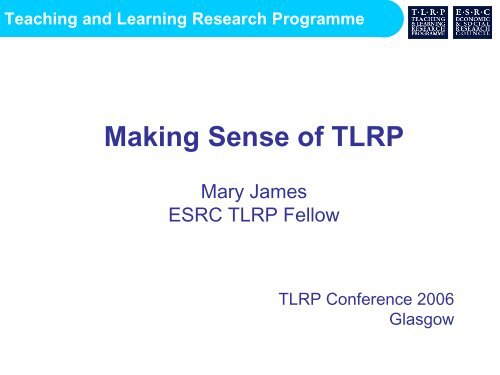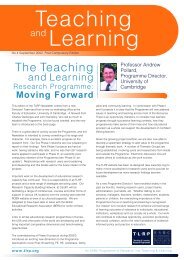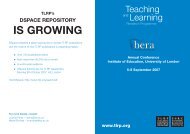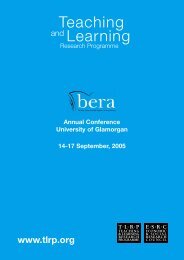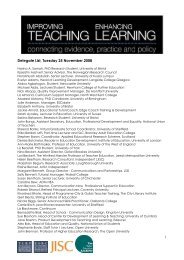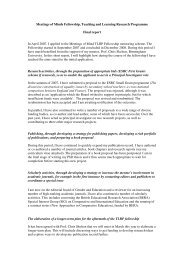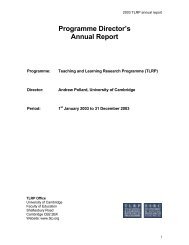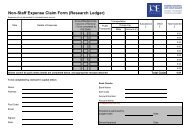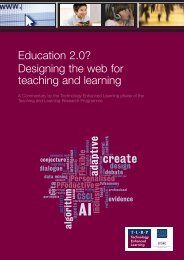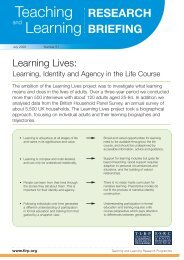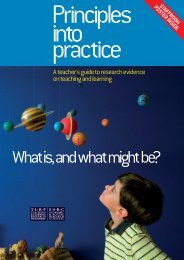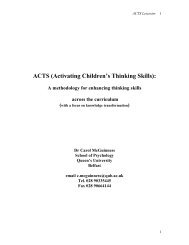Mary James - Making sense of TLRP presentation (pdf)
Mary James - Making sense of TLRP presentation (pdf)
Mary James - Making sense of TLRP presentation (pdf)
Create successful ePaper yourself
Turn your PDF publications into a flip-book with our unique Google optimized e-Paper software.
Teaching and Learning Research Programme<strong>Making</strong> Sense <strong>of</strong> <strong>TLRP</strong><strong>Mary</strong> <strong>James</strong>ESRC <strong>TLRP</strong> Fellow<strong>TLRP</strong> Conference 2006Glasgow
Teaching and Learning Research ProgrammeAim:An interactive opportunity• to provide an opportunity to refine some initial thinking aboutfindings across <strong>TLRP</strong>, as a basis for further work in 2007.Background:• Initial work: reviewing 22 school-based projects resulted in aschools’ commentary incorporating 10 principles (43,478 downloadsMarch to Oct).• Iterative process: bottom-up from project findings and top-downfrom <strong>TLRP</strong> conceptual framework.• Subsequent testing: against expected findings from post-compulsoryprojects.
Teaching and Learning Research ProgrammePolitical, economic and cultural contextsInformal and formal learning contextsLearners andlearning throughthe lifecourseCurriculum and domainknowledgeInteraction and pedagogyinformation technologyAssessment and learningTeachers, teachingand trainingLearning outcomesEducational issuesInternationalcomparisons
Teaching and Learning Research ProgrammeProcess <strong>of</strong> this session• Update on 10 principles drawing in cross phaseand drawing out key messages/dilemmas/issues(35 minutes)• Draft individual comments (on handout: twogeneral questions, and principles) (10 minutes)• Discussion around posters; annotate with post-itnotes (30 minutes)• Revise individual comments on handouts (15minutes)
Teaching and Learning Research ProgrammeEffective teachingand learning .......
Teaching and Learning Research Programme1. EQUIPS LEARNERSFOR LIFE IN ITSBROADEST SENSE
Teaching and Learning Research ProgrammeP1 Questions• Is this more aspiration than evidence based,within <strong>TLRP</strong>?• Do we really have evidence <strong>of</strong> broaderoutcomes (defined and/or assessed)?• Were we constrained by the currency(performance measures) <strong>of</strong> the time, or by thedesign <strong>of</strong> development and research projects?• Is there change in orientation in projects begunlater in <strong>TLRP</strong> or in post-compulsory settings?Why?
Teaching and Learning Research Programme2. ENGAGES WITHVALUED FORMS OFKNOWLEDGE
Teaching and Learning Research ProgrammeP2 Questions• Are these ideas too ‘schooly’ or do theygeneralise to other sectors?• Do they underplay the values dimension andcontestation within domains?• Do they emphasise individual cognition andunderplay learning in and through socialactivity?• How might these ideas be better expressed?
Teaching and Learning Research Programme3. RECOGNISES THEIMPORTANCE OF PRIOREXPERIENCE ANDLEARNING
Teaching and Learning Research ProgrammeP3 Questions• Does this also underplay contested valuesassociated with cultural diversity?• Does this privilege cognitive constructivist orsocial constructivist views <strong>of</strong> learning?• Does it presuppose linear or hierarchical models<strong>of</strong> progression?• Does this accurately reflect the emphases in ourschools’ projects?• Should socio-cultural approaches receive equalemphasis, especially if we extend the principlesto accommodate post-16 projects?
Teaching and Learning Research Programme4. REQUIRES THE TEACHER TOSCAFFOLD LEARNING
Teaching and Learning Research ProgrammeP4 Questions• This principle draws heavily on Vygotsky, Bruner etc,who are frequently quoted by schools’ projects. Is thispedagogical focus too narrow? Have we the evidence tobroaden and deepen it?• Do we need to give more attention to mobilisation anduse <strong>of</strong> resources?• Should we emphasise the centrality <strong>of</strong> relationships atthe core <strong>of</strong> the curriculum, pedagogy, assessmenttriangle?• Can we use or develop theory to account for informal,tacit and vicarious learning?• Is the theory confounded by reality e.g. the capability <strong>of</strong>teachers to scaffold the learning <strong>of</strong> others?
Teaching and Learning Research Programme5. NEEDS ASSESSMENT TO BECONGRUENT WITH LEARNING
Teaching and Learning Research ProgrammeP5 Questions• Is this also more aspiration than evidence-basedwithin <strong>TLRP</strong>?• What evidence do we have <strong>of</strong> innovation inassessment practice?• Are consistency (reliability) and congruence withexpanded learning outcomes (validity) intension?• Do we have anything to say about a resolution?
Teaching and Learning Research Programme6. PROMOTES THEACTIVE ENGAGEMENTOF THE LEARNER
Teaching and Learning Research ProgrammeP6 Questions• The development <strong>of</strong> learners’ agency,independence, autonomy, identity anddisposition emerge strongly from schoolbasedprojects. Is this equally true post-16?• Do we need to nuance our discussion anduse <strong>of</strong> these concepts? How?• Are we really talking about developinglearners’ ability to manage their learning?
Teaching and Learning Research Programme7. FOSTERS BOTHINDIVIDUAL AND SOCIALPROCESSES ANDOUTCOMES
Teaching and Learning Research ProgrammeP7 Questions• We have strong school-based evidence <strong>of</strong> theeffectiveness <strong>of</strong> collaborative learning but isthere any inherent contradiction with Principle 6?• Do we have sound evidence <strong>of</strong> learning asknowledge-creation (a third metaphor) to setalongside learning as acquisition and learning asparticipation?• What is our evidence – beyond rhetoric – thatthe voices <strong>of</strong> all groups <strong>of</strong> learners are heard?
Teaching and Learning Research Programme8. RECOGNISES THESIGNIFCANCE OFINFORMAL LEARNING
Teaching and Learning Research ProgrammeP8 Questions• Contestation <strong>of</strong> values is important. Does it havemore prominence post-16 than in the schools’model?• Should we distinguish three dimensions:formal/informal; voluntary/compulsory;within/beyond institutions? For example,informal learning occurs within school andformal learning occurs out <strong>of</strong> school.• Are ‘identities’ and ‘literacies’ key constructshere?
Teaching and Learning Research Programme9. DEPENDS ONTEACHER LEARNING
Teaching and Learning Research ProgrammeP9 Questions• Do we need to expand this to cover non-teaching staffi.e. in extended schools?• What are the implications <strong>of</strong> considering teachers aslearners e.g. management <strong>of</strong> their own learning careers?• In emphasising knowledge and practice do we neglectthe affective dimension e.g. the emotional labour <strong>of</strong>teaching?• If there is strong evidence <strong>of</strong> constraints on teachers’practice, do we have any idea what the consequencesmight be <strong>of</strong> releasing them from these constraints?
Teaching and Learning Research Programme10. DEMANDS CONSISTENT POLICYFRAMEWORKS WITH SUPPORT FORTEACHING AND LEARNING AS THEIRPRIMARY FOCUS
Teaching and Learning Research ProgrammeP10 Questions• Do we need to unpack this further in thefollowing ways:– By being more explicit about system andinstitutional structures e.g. the role <strong>of</strong> the 3rdsector (voluntary), and internal organisation <strong>of</strong>institutional settings.– By analysing constraints and affordances inthese sub-contexts?
Teaching and Learning Research ProgrammeOverallUnpack, amend, expand• Pedagogy• Pr<strong>of</strong>essional development• Institutional/system policyCreate space (or new principle)• Progression/ time dimension• Language• Relationships/ interaction• Resources/tools
Teaching and Learning Research ProgrammeThe Challenges• How to do justice to all our projects?• How to capture complexity and richness inwords that practitioners can hold in theirheads as they practice?• How to create a set <strong>of</strong> principles thatcohere? Should we be doing this anyway?
Teaching and Learning Research ProgrammeNext steps• Activity 1: draft individual responses onhandouts (10 minutes)• Activity 2: discuss and annotate one or twoprinciples at posters (30 minutes)• Activity 3: amend, expand individual responseson handouts as necessary (15 minutes)• Activity 4: Return handouts to <strong>Mary</strong> who will tryto make <strong>sense</strong> <strong>of</strong> them (in time!)
Teaching and Learning Research Programme


